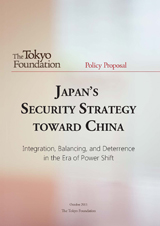- Policy Proposal
- Comparative and Area Studies
Japan’s Security Strategy toward China: Integration, Balancing, and Deterrence in the Era of Power Shift
October 31, 2011
The following is the Executive Summary of the Policy Proposal issued by the Tokyo Foundation's Asia Security Project, led by Tokyo Foundation Research Fellow and Keio University Associate Professor Ken Jimbo . Click here to download the full Proposal (PDF 1.1MB).
Power Shift and Power Transition: Case for Japan-China Relations
The rise of China is rapidly changing the strategic landscape in the Asia-Pacific region. As China becomes a leading power in Asia, China’s growing influence is shifting the strategic weight of bilateral and regional security relations. The rise of China is also a global phenomenon. The distribution of global wealth is becoming further multipolarized and diversified as China’s nominal GDP is braced to match that of the United States and EU. China, along with other emerging economies in the world, may gradually alter the rules, norms and institutions of global governance. Thus, for policymakers in Japan, the days of old-fashioned management of Japan-China bilateral relations may become utterly obsolete. Accordingly, Japan’s strategy toward China should be readjusted as constituting the core of Japan’s regional strategy in East Asia and a gateway for a strategy toward the emerging powers in the world.
One prevailing views suggests that as China becomes more powerful and the US position erodes, it will inevitably lead to serious strategic competition between China and the liberal order predominantly led by the United States. The result of such developments will be heightened tensions, distrust, and conflict during the process of power shift. However, other views assert that while the “unipolar moment” will inevitably end, China can comfortably accommodate the United States since China has already been highly integrated into the liberal international order. In this view, the US-China relationship will not necessarily be confrontational but will have the potential of peaceful co-existence between the two leading powers. Indeed, the Chinese government has repeatedly proclaimed that China would be able to rise to prominence in a peaceful manner that would not challenge the existing order.
The peaceful rise of China, however, is not an easy goal to be realized without bridging a crevasse between China and the liberal order. China’s fundamental claims on territorial integrity and “core interests” are giving rise to tensions with neighboring states. China’s promotion of state capitalism, heavy intervention in the market, and tight currency control have been sources of economic friction with the leading economies of the world. China’s limited progress on democracy, human rights and the rule of law also pose a problem in sharing common values. In realizing the peaceful rise of China, China needs to clarify its road to bridge the gap between concept and reality.
Japan’s security strategy toward China must be based on an assessment of the dynamism of China’s changing status in the power distribution in the Asia-Pacific, China’s approach and strategy for Asian security order, and how much Japan, the US-Japan alliance, and other regional partners can shape the strategic choice of China. As described in Part I-4, our project proposes integration , balancing , and deterrence as Japan’s three-layered security strategy toward China. This approach aims to overcome shortcomings of the simple binomial framework of engagement and hedging because (1) China is no longer outside the international system, so that days of engaging China is over; and (2) in order to shape China’s strategic choices so that China conforms to the liberal order, we need more proactive approaches beyond merely hedging against China. Japan should enhance its efforts to integrate China into bilateral, regional, and global orders, balance China to induce China to become a full-fledged member of the international community by making it expensive for China not to comply with international rules and norms, and should deter China from attempting to change the status-quo by force.
For Japan, the year 2010 brought the dawn of a full-scale encounter with the rise of China. China became the world’s second-largest economy in 2010, as its nominal GDP overtook Japan’s. China also became Japan’s top trading partner, replacing the US in 2009. As Japan-China economic relations become highly interdependent based on mutual interests, the two countries are now hardly separable. However, mutual distrust and tensions linger in bilateral security relations, as highlighted in the confrontation over the Senkaku Islands (known as the Diaoyu Islands in Chinese) in September 2010. The incident also brought to light the fact that Japan and China had few effective mechanisms to reduce danger, manage crises, or increase their common interests over bilateral security issues. As China is advancing the level of military activity in the East China Sea, and Japan is correspondingly placing emphasis on defending its southwestern territory, there is a greater need to fill the vacuum of stability and crisis management in Japan-China security relations.
US-China-Japan GDP and Military Spending in 2030
Japan’s China strategy should be founded upon the objective assessment of the future distribution of power, especially among Japan, the United States, and China. For this purpose, our project conducted research on economic projection and military spending trends toward 2030. Referencing the various economic projection studies of the International Monetary Fund’s World Economic Outlook and Goldman Sachs reports, etc., we have updated and modified the projection trends reflecting the changes after the global financial crisis in 2008.
Our estimate suggests that China will surpass the US in GDP (nominal terms, in US dollar as of 2010) and become the world’s biggest economy in 2026 (see Part I-1). In 2030, it is projected that US nominal GDP will be 28.4 trillion dollars, China’s 34.7 trillion dollars, and Japan’s 8.4 trillion dollars. The ratio of the size of GDP among the US, China, and Japan will be 3.4 to 4.1 to 1..
Our study also discovered that future projections of China’s military spending will also pose a challenge to US primacy. Most of the previous studies argued that China would not be able to compete with the US in the military domain despite its economic ascendancy. Although military power should be measured in a comprehensive manner, our project decided to compile a long-term outlook on national defense spending based on the GDP projection. We worked with a simple assumption, calculating defense spending as a fixed percentage of GDP, with high and low estimate paths for the US and China (See Part I-2).
By the year 2030, China’s high-end path will surpass the US defense-cut path, reversing the ranking of military spending by two countries (see Figure 6). We are not suggesting that such a power transition will become reality but are simply calling attention to the fact that a power shift is occurring at a much faster pace than most experts believe. The projection manifests in even more drastic form in Japan-China relations. China’s national defense spending is rising beyond Japan’s defense expenditures at a rapid rate, and the military balance between Japan and China is expected to become one of overwhelming ascendancy for China. Chinese defense spending will be 4.8 times (6.5 times in the high-end estimate) larger than that of Japan’s in 2020 and 9.1 times (12.7 times) larger in 2030. The power transition is a reality of the Japan-China relationship, and this foretells of a coming era when Japan will find it increasingly difficult to deal with China's military rise with its own resources alone.
Japan’s Security Strategy toward China: Integration, Balancing and Deterrence
Against this background, Japan’s security strategy toward China in this era of dynamic power shift in Japan-US-China relations should be designed as a three-layered approach consisting of integration, balancing, and deterrence.
An integration strategy should involve (1) deepening the partnership and interdependence in both economic and security domains (extended engagement), (2) managing risks and crises in Japan-China security relations through cooperation and institutions (risk/crisis management), and (3) expand strategic cooperation in the Asia-Pacific region. It is important for Japan to encourage China to play a constructive and proactive role in the regional economic and security architecture, while promoting bilateral cooperation based on common interests. At the same time, Japan and China should deeply institutionalize their dialogue and communication channels among defense officials in order to manage the potential bilateral risks and crises. Further, Japan should promote China’s full-fledged membership in the liberal international order by encouraging the country’s representation and presence in international and regional organizations.
A balancing strategy should be promoted in a comprehensive manner (hard balancing, soft balancing, and institutional balancing) to shape China’s strategic choices. Balancing begins with diplomatic competition that results in higher eventual costs for China in case of its noncollaboration. Balancing further extends to forming coalitions without China (external balancing) while supporting the capacity of nations in the Asia-Pacific region to deal with China (capacity building for internal balancing). Balancing will be more effective when regional members agree not to cooperate with China. However, it is critically important to confirm that the aim of a balancing strategy is to promote integration. We suggest that the balancing strategy be regarded as a pilot for navigating China toward a path of cooperation. Such navigation needs to be founded of a balance of power. Our project asserts that the Asia-Pacific region needs regional preparedness and collective capacity to counterbalance China.
Deterrence represents the leading edge of national security. If China advances the creeping expansion of its military activities in disputed areas, or if it decides to resolve conflicts by force, such actions to change the status quo will have to be deterred. Our project recommends that Japan needs to enhance the operational domain of the Self-Defense Forces around the Nansei Islands by promoting intelligence, surveillance, and reconnaissance (ISR) activities. We also assert that the Japan-US alliance will need to adjust to the new strategic reality under China’s anti-access and area-denial (A2/AD) environment. The new operational concept of the Joint Air-Sea Battle should be explored in the alliance agenda. It is also very important to increase the roles and capacities of Japan in dealing with low-intensity friction and conflicts with China while maintaining the Japan-US alliance that plays an indispensable role in escalation control and extended deterrence.
In the light of the above observations and basic principles for Japan’s security strategy toward China, our project offers 15 specific policy proposals as follows:
Integration
1. Form a resilient habit of cooperation capable of withstanding the power shift
2. Explore new frontiers in Japan-China security cooperation
3. Reinforce the crisis management mechanisms in place at the Japan-China summit level and between their national defense authorities
4. Gain access to Chinese-led frameworks and take steps toward two-way integration
Balancing
5. Inaugurate a Japan-US-China strategic security dialogue
6. Strengthen security cooperation with Australia, South Korea, India, and Southeast Asia
7. Promote functional and ad-hoc regional cooperation
Deterrence
8. Promote dynamic deterrence with respect to opportunistic expansion by China
9. Promote a Japan-US joint air-sea battle (JASB) concept
Integration and Balancing
10. Utilize Japan-South Korea strategic cooperation wisely
11. Promote regional cooperation with China through the six-party talks and Japan-China-South Korea cooperation
12. Prepare for a North Korean destabilization scenario
Integration
13. Bring China into the extensive array of regional security cooperation arrangements
Balancing
14. Build “a coalition of the willing” within regional institutions
15. Promote the reform of regional institutions


